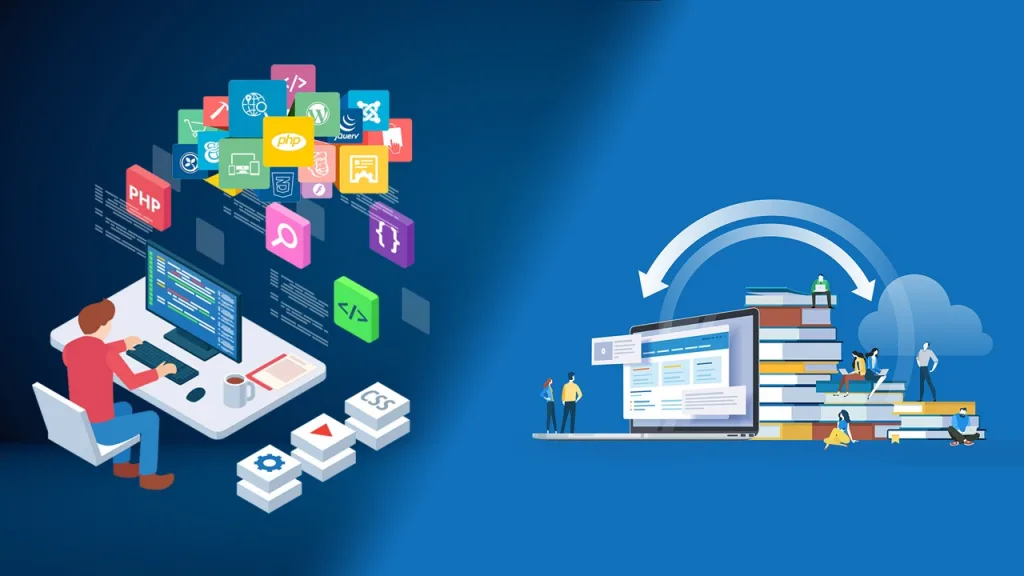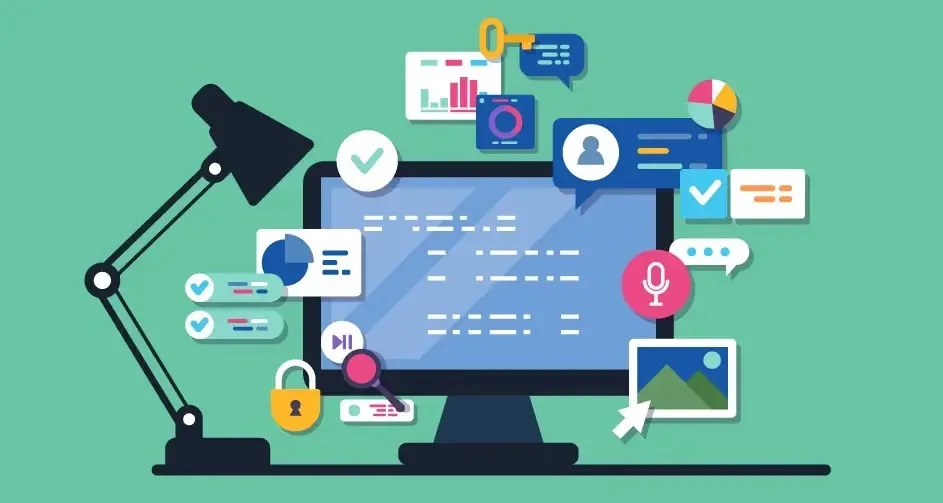Discover Top-Tier Software Outsourcing Products
Explore a wide range of software outsourcing products that cater to every project’s unique requirements. From dedicated teams to full project management, these solutions offer expert support to drive innovation and efficiency.

Web System
A web system is a collection of software and hardware components designed to provide services and functionality via the internet or an intranet.
Web systems today have become a crucial platform for many online applications and services, ranging from simple websites to complex web applications serving millions of users worldwide.

Main Components of Web System
Web Front-end
The Front-end is what the user sees and includes visual elements like buttons, checkboxes, graphics, and text messages. The frontend allows the user to interact with the application.
Three main computer languages influence how users interact with your frontend:
- HTML (Hypertext Markup Language): The standard language for creating web pages and web applications. HTML provides the basic structure of a webpage.
- CSS (Cascading Style Sheets): Used for describing the look and formatting of a document written in HTML. CSS is responsible for the visual presentation of the web page.
- JavaScript: A programming language that enables interactive elements on web pages, such as dynamic content updates, interactive forms, animations…
Web back-end
The Backend is the data and infrastructure that makes your application work. When a user interacts with the frontend, the interaction sends a request to the backend in HTTP format. The backend will process the request and return a response.
Programming Languages and Frameworks:
- Java: Java is an object-oriented programming language widely used in large-scale enterprise applications due to its stability and high performance.
- Python: Python is a high-level, interpreted programming language known for its simplicity and versatility. It is widely used in back-end development due to its clear syntax and extensive libraries.
- Node.js is a server-side JavaScript runtime environment, enabling back-end development with JavaScript.
- PHP is a popular server-side scripting language, particularly strong in web development.
- C# (C-Sharp) is a modern, object-oriented programming language developed by Microsoft as part of the .NET framework. It is widely used in the development of Windows applications, web services, enterprise applications, and video games.
Database
Databases are used to store, retrieve, and manage data. They are crucial for persisting user data, application state, and other necessary information.
Web Server
Web servers handle incoming requests from clients (e.g., web browsers), process these requests, and send back the appropriate responses.
API
APIs allow different software systems to communicate with each other. They are essential for integrating various services and for enabling communication between the front-end and back-end.
Security Components
Security is vital to protect the web system from threats and vulnerabilities.
Monitoring and Logging Tools
To ensure the web system is running smoothly and efficiently, monitoring and logging are critical.
Adavntages of Web System
- Accessibility: Accessible from anywhere with an internet connection.
- Cross-Platform: Operates across multiple devices and operating systems.
- Cost-Effective: Reduces hardware and maintenance costs compared to traditional applications.
- Real-Time Updates: Easy to update and maintain without the need for user-side installations.
With over 10 years of experience in web system development, PadiTech stands out in delivering cutting-edge and efficient solutions tailored to meet the unique needs of our clients. Our team of experts leverages a wealth of knowledge and advanced technologies to create robust and scalable web applications, ensuring optimal performance and user satisfaction.
Mobile App
A mobile app (or mobile application) is a software application developed specifically for use on small, wireless computing devices, such as smartphones and tablets, rather than desktop or laptop computers.

Types of Mobile Apps
Native mobile apps
Native app development serves a single operating system or platform. They use a programming language that’s specific to that platform or operating system. This is usually a choice of iOS, Android…
Web mobile apps
Web apps are types of mobile apps that draw from web-based technologies. They’re accessed through a mobile device’s web browser, so avoid any download or install onto a device. They’re also internet-enabled which gives them added flexibility and a more responsive design that can work on any mobile device or operating system.
Hybrid Apps
Of all the different types of mobile apps, a hybrid app is a combination of a native app and a web app. In practice, it’s developed as a web app in a native app container. By leveraging certain native platform features and device hardware, hybrid apps offer the benefits of a native experience while flexing to non-native environments. Ex: Instagram, Slack…
Popular Cross-platform Mobile Application Development Frame-work
Native Apps
Native Apps are applications developed specifically for a particular mobile platform, such as iOS or Android. They use platform-specific programming languages and development tools.
- iOS: Developed using Swift or Objective-C and built with Xcode.
- Android: Developed using Java or Kotlin and built with Android Studio.
ADVANTAGES:
- High Performance: Code is compiled directly for the specific platform, ensuring optimal performance.
- Platform Optimization: User interfaces are tailored to meet platform-specific guidelines.
- Full Access: Complete access to platform-specific APIs and device features.
DISADVANTAGE:
- Higher Cost: Development and maintenance can be more expensive as separate codebases are required for each platform.
React Native
React Native is an open-source framework developed by Facebook that allows building mobile applications using JavaScript and React. The code written in JavaScript and React is compiled into native code for both iOS and Android.
ADVANTAGES:
- Code Reusability: The same codebase can be used for both iOS and Android, reducing development time and cost.
- Large Community: A robust development community and numerous libraries are available for support.
- Good Performance: Offers performance close to native apps, particularly for less complex applications.
DISADVANTAGES:
- Performance Limitations: May not match native performance for high-performance tasks or complex graphics.
- Native Feature Integration: Some native features may be challenging to integrate.
Flutter
Flutter is an open-source framework developed by Google, using the Dart programming language. Flutter allows you to build mobile applications for both iOS and Android from a single codebase.
ADVANTAGES:
- High Performance: Apps are compiled to native code, delivering performance close to native apps.
- Customizable UI: Provides extensive tools for creating visually appealing and highly customizable user interfaces.
- Hot Reload: Allows for instant updates to the code and immediate visual feedback without restarting the app.
DISADVANTAGES:
- Smaller Community: Although growing, Flutter’s community and ecosystem are smaller compared to React Native.
- Dart Language: Dart is less common than JavaScript, which may make it harder to find developers.
PadiTech proudly stands as a leading partner in mobile app development, offering comprehensive solutions across native, React Native, and Flutter platforms. With a team of experienced engineers and extensive expertise, we are committed to delivering high-quality products with outstanding performance and exceptional user experiences.
Tester
A tester is the person responsible for testing software to ensure that the product works as expected and without errors. The tester’s goal is to find problems, bugs, and requirements mismatches to help the development team improve product quality.

Classification of Tester
Manual Testing
Manual Testing is a software testing method where the tester performs testing activities manually without using automation tools. In Manual Testing, the tester acts as an end-user, interacting with and checking the features, functionalities, interfaces, and other aspects of the software to ensure it works as expected and meets requirements.
The main functions of Manual Testing include:
- Preparing Test Scenarios: Testers create test scenarios based on the software requirements and analysis documents. Test scenarios define the specific test steps that the tester will perform.
- Executing Tests: Testers manually execute the steps in the test scenarios. They check the software’s features, functionalities, and interfaces, enter data, interact with components, and verify the results to determine if the software works correctly.
- Recording Results: Testers record the results of each test step, including expected and actual outcomes. They also document any bugs or issues found during testing.
- Debugging: If errors occur during testing, testers debug to identify the root cause of the error and report it to the development team for fixing.
- Evaluation and Reporting: Testers evaluate the test results and prepare a report on the test status, detected bugs, and other issues related to the software. This report provides valuable information for the development team to improve software quality.
Automation Testing
Automation Testing is the process of using software and automation technology to execute software test scenarios. Instead of performing tests manually, testers use tools and automation techniques to execute test steps, compare actual results with expected results, and generate test result reports.
The main tasks of Automation Testing include:
- Creating Automated Test Scripts: Testers use tools and programming languages to build automated test scripts. These scripts include test steps, input data, and expected test results.
- Executing Automated Tests: Automated test scripts are executed by automation tools and frameworks. These tools interact with the application or system under test, perform test steps, enter data, and check results.
- Comparing Results: Automation tools compare the actual test results with the expected results defined in the test scripts. Any discrepancies are recorded and reported as bugs.
- Generating Test Reports: Automation tools provide detailed reports on the automated testing process. These reports include information about the number of test steps executed, the number of bugs detected, and the overall test results.
The Perfect Collaboration Between AI and Testers
The collaboration between Artificial Intelligence (AI) and testers represents a transformative approach in software development, enhancing both efficiency and accuracy. AI automates repetitive testing tasks, allowing testers to focus on more complex and nuanced aspects of the software. By quickly executing numerous test cases, AI identifies discrepancies and patterns that might be overlooked manually, thus accelerating the testing process and improving bug detection.
AI’s capability for continuous and comprehensive testing ensures that issues are identified early in the development lifecycle. This ongoing analysis helps maintain consistent software quality and reduces the risk of major defects being discovered late in the process. While AI handles the heavy lifting of repetitive tasks, human testers bring essential insight and creativity to the table. They interpret AI-generated results, optimize testing strategies, and ensure that the software meets user expectations.
PadiTech embraces this synergy between AI and human expertise to deliver superior software testing solutions. By leveraging both AI and human skills, we ensure an effective and reliable software development process.
BA (Business Analyst)
Business analysts use data to form business insights and recommend changes in businesses and other organizations. Business analysts can identify issues in virtually any part of an organization, including IT processes, organizational structures, or staff development.

Business Analyst Role and Responsibilities
Requirements management
Requirements management is a key part of business analyst roles and responsibilities. The complexities of the modern business environment mean most companies need someone to maintain requirements that constantly change, utilizing modern innovations along the way.
Data Analysis
Business analysts constantly analyze data to identify potential issues that could affect other areas. They use this analysis to detect inefficiencies or problems that may not have been noticed yet, helping their companies save time and money.
Tech Research
They stay updated on the latest technology trends to modernize systems and processes. By researching current IT advancements, business analysts find solutions to organizational challenges, minimize compliance risks, and safeguard customer data.
Presenting Findings
Business analysts prepare and deliver presentations to stakeholders, using data to make a compelling case for necessary changes. They effectively communicate why these changes are needed, even if it means deviating from established practices.
Developing Projects
They lead special projects to address modern business challenges. This involves collaborating with, training, and guiding other team members, as well as working closely with senior management and clients to develop and implement new initiatives.
Change Management
As agents of change, business analysts manage the implementation of new processes. They conduct test runs and track the outcomes of changes to ensure a smooth transition and effective results within the organization.
Trends and Developments in Business Analyst
Enhanced Data Analytics
The use of advanced data analytics is increasingly prevalent in business analysis. Tools for big data and predictive analytics allow business analysts to derive deeper insights from large volumes of data. This capability improves decision-making by uncovering trends and patterns that might otherwise go unnoticed.
Process Automation
Automation is a key trend in business analysis. Automated tools streamline tasks like requirement gathering, process checking, and reporting. This reduces manual effort and enhances efficiency, enabling analysts to focus on strategic tasks and higher-value activities.
Adoption of Agile Methodologies
Agile methodologies are becoming more common in business analysis. Agile emphasizes flexibility and rapid response to change, allowing organizations to adapt projects and processes based on real-time needs. Business analysts working in Agile environments collaborate closely with development teams to ensure timely and effective delivery of solutions.
Integration of Artificial Intelligence (AI)
Artificial Intelligence (AI) is playing a significant role in business analysis. AI technologies, such as machine learning algorithms, enhance data analysis and forecasting capabilities. This integration helps analysts automate complex analyses and generate innovative solutions to business challenges.
Focus on Customer Experience
A growing emphasis on customer experience is shaping business analysis. Analysts are increasingly analyzing customer feedback to enhance products and services. By using tools to assess customer interactions, organizations can identify pain points and opportunities for improvement, ultimately boosting customer satisfaction.
At PadiTech, our team of Business Analysts stays ahead of industry trends by utilizing advanced data analytics, automation, and Agile methodologies. We integrate AI technologies and focus on customer experience to deliver innovative, high-impact solutions. With our dedicated BA team, we are committed to delivering high-quality, impactful results that drive your business forward.
PM (Project Manager)
A project manager is a professional who organizes, plans, and executes projects while working within restraints like budgets and schedules. Project managers lead entire teams, define project goals, communicate with stakeholders, and see a project through to its closure.

Role of a Project Manager
The Project Manager is responsible for overseeing and managing the project from start to finish. They ensure the project stays on track, meets objectives, and manages resources, team leadership, risk, scheduling, communication, and quality effectively.
Project Planning
A Project Manager is responsible for defining the scope, goals, tasks, schedule, resources, and budget for a project. They need to establish a detailed plan to ensure that the project is executed on time and meets the specified requirements.
Resource Management
The Project Manager must manage project resources, including personnel, materials, equipment, and budget. They need to allocate and manage resources appropriately to ensure the project runs smoothly and achieves the desired results.
Leadership and Team Management
The Project Manager is responsible for leading and managing the project team. This includes assigning tasks, monitoring work progress, creating a positive work environment, and encouraging collaboration among team members.
Risk Management
The Project Manager identifies and assesses potential risks that could impact the project and implements preventive and responsive measures. They monitor, control, and manage risks throughout the project to minimize negative effects on the final outcome.
Schedule Management
The Project Manager oversees the project schedule, ensuring that tasks are completed according to the plan. Based on progress, they adjust and replan as necessary to ensure the project meets deadlines and timelines.
Communication
The Project Manager serves as the main point of contact between project stakeholders, including team members, clients, partners, and other interested parties. They facilitate information flow, resolve conflicts, and build strong relationships with all stakeholders.
Quality Control
The Project Manager ensures that the final product or service meets quality standards. This involves establishing quality criteria, monitoring performance, and conducting regular checks to maintain quality throughout the project.
Necessary Skills for a PM
Leadership Skills
Leadership is a crucial skill for a Project Manager. They need the ability to guide and inspire the team to achieve project goals. Leadership skills include building strong relationships, motivating team members, and effectively addressing any issues that arise.
Time Management Skills
Effective time management is essential to ensure that the project is completed on schedule. A Project Manager must establish clear milestones, create detailed plans, and monitor progress. They also need to prioritize tasks and handle emergencies to keep the project on track.
Communication Skills
Strong communication skills are necessary for a Project Manager to convey information clearly and effectively to all stakeholders. This includes the ability to listen, write clear reports and emails, and organize meetings to discuss project progress and issues.
Problem-Solving Skills
Problem-solving skills help a Project Manager tackle challenges and issues that arise throughout the project. They need to analyze situations, explore feasible solutions, and make quick and effective decisions.
Organizational Skills
Organizational skills help a Project Manager arrange and manage all aspects of the project efficiently. They need to create clear structures and processes to ensure tasks and resources are managed effectively and the project runs smoothly.
Negotiation Skills
Negotiation skills are essential for managing relationships with stakeholders, including clients, vendors, and partners. A Project Manager must be able to negotiate contract terms, resolve conflicts, and reach agreements that benefit the project.
Budget Management Skills
Budget management requires a Project Manager to track and control project costs to ensure they do not exceed the allocated budget. They need to allocate finances appropriately, manage unexpected costs, and adjust the budget as necessary.
At PadiTech, our expert Project Managers deliver projects on time and within budget, leveraging their strong leadership, time management, and communication skills. We ensure high-quality outcomes and smooth execution, making us your ideal partner for successful project management.






